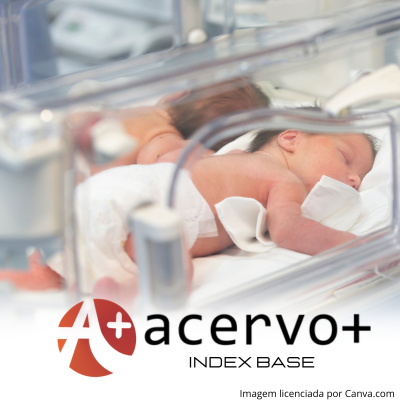O uso de hipotermia induzida no manejo da asfixia neonatal
##plugins.themes.bootstrap3.article.main##
Resumo
Objetivo: Analisar as repercussões clínicas e a legitimidade da instituição da hipotermia terapêutica induzida no manejo dos quadros de asfixia neonatal. Métodos: Foi feito uma revisão integrativa da literatura de abordagem qualitativa e transversal com artigos relatados entre 2005 e 2022 disponíveis nas bases de dados National Library of Medicine (PubMed) e Scielo, com os descritores “encephalopathy”; “hypothermia induced”; “asphyxia neonatorum”; “resuscitation neonatorum” os quais foram triados a partir de critérios de inclusão e exclusão, selecionados os 16 artigos de relevância que foram analisados nessa revisão. Resultados: Foi constatada redução da mortalidade, menos intercorrências nos primeiros dias de vida dos bebês, também foi relatado benefícios a médio prazo decorrentes do uso da terapia como redução dos casos de paralisia cerebral, melhor desenvolvimento cognitivo e motor. Considerações finais: De forma geral constatou-se que o resfriamento oferece melhores desfechos clínicos, além de ser neuro protetor, por isso sua instituição traz grandes benefícios no manejo da asfixia neonatal, justificando assim sua legitimidade, porém ainda faltam estudos que preconizem uma metodologia específica de aplicação da hipotermia.
##plugins.themes.bootstrap3.article.details##
Copyright © | Todos os direitos reservados.
A revista detém os direitos autorais exclusivos de publicação deste artigo nos termos da lei 9610/98.
Reprodução parcial
É livre o uso de partes do texto, figuras e questionário do artigo, sendo obrigatória a citação dos autores e revista.
Reprodução total
É expressamente proibida, devendo ser autorizada pela revista.
Referências
2. ALMEIDA MF, et al. Reanimação do recém-nascido ≥34 semanas em sala de parto: Diretrizes 2022 da Sociedade Brasileira de Pediatria. Sociedade brasileira de pediatria, 2022: 0-40.
3. AZZOPARDI D, et al. Effects of Hypothermia for Perinatal Asphyxia on Childhood Outcomes. New England Journal of Medicine, 2014 Jul 10; 371(2): 140–9.
4. AZZOPARDI D, et al. Moderate hypothermia within 6 h of birth plus inhaled xenon versus moderate hypothermia alone after birth asphyxia (TOBY-Xe): a proof-of-concept, open-label, randomised controlled trial. The Lancet Neurology, 2016 Feb 1; 15(2): 145–53.
5. AZZOPARDI DV, et al. Moderate Hypothermia to Treat Perinatal Asphyxial Encephalopathy. New England Journal of Medicine, 2009 Oct; 361(14): 1349–58.
6. BADAWI N, et al. Intrapartum risk factors for newborn encephalopathy: the Western Australian case-control study. BMJ, 1998 Dec 5; 317(7172): 1554–8.
7. CAMPBELL H, et al. Hypothermia for perinatal asphyxia: trial-based quality of life at 6–7 years. Archives of Disease in Childhood, 2018 Jul 1; 103(7): 654–9.
8. DEFERM N, et al. Glomerular Filtration Rate in Asphyxiated Neonates Under Therapeutic Whole-Body Hypothermia, Quantified by Mannitol Clearance. Clinical Pharmacokinetic, 2021, Jul 1 [cited 2022 Oct 2]; 60(7): 897–906.
9. ERIKSEN VR, et al. Lactate acidosis and cardiac output during initial therapeutic cooling in asphyxiated newborn infants, 2019 ; Mar 14: 14(3).
10. FERNANDES VL, et al. Fatores de risco para asfixia perinatal em recém-nascidos atendidos em uma maternidade pública terciária. Resid Pediatria, 2020; 10(2): 1-6.
11. GE J, et al. Neural Function Recovery and Safety of Mild Hypothermia Therapy Combined with Monosialotetrahexosylganglioside on Neonatal Asphyxia Complicate by Hypoxic Ischemic Encephalopathy. Tang M, editor. Computational and Mathematical Methods in Medicine, 2021 Dec 27; 2021: 1–8.
12. GE J, et al. Neural Function Recovery and Safety of Mild Hypothermia Therapy Combined with Monosialotetrahexosylganglioside on Neonatal Asphyxia Complicated by Hypoxic Ischemic Encephalopathy. Tang M, editor. Computational and Mathematical Methods in Medicine, 2021 Dec 27; 2021: 1–8.
13. JACOBS SE, et al. Cooling for newborns with hypoxic ischaemic encephalopathy. Cochrane Database Syst Rev, 2013 Jan 31; 2013(1), edição 4.
14. LAKSHMINRUSIMHA S, et al. Pulmonary Hypertension Associated with Hypoxic-Ischemic Encephalopathy—Antecedent Characteristics and Comorbidities. The Journal of Pediatrics, 2018 May; 196: 45-5e3.
15. LAPTOOK AR, et al. Prediction of Early Childhood Outcome of Term Infants using Apgar Scores at 10 Minutes following Hypoxic-Ischemic Encephalopathy. Pediatrics, 2009 Dec 1; 124(6): 1619.
16. LEE AC, et al. Neonatal resuscitation and immediate newborn assessment and stimulation for the prevention of neonatal deaths: a systematic review, meta-analysis and Delphi estimation of mortality effect. BMC Public Health], 2011; 11(Suppl 3): S12.
17. NATAJARAN G, et al. Apgar scores at 10 min and outcomes at 6-7 years following hypoxic-ischaemic encephalopathy. Archives of Disease in Childhood Fetal and Neonatal Edition, 2013 Nov 1;98(6): F473-479.
18. NUNES A, et al. Oxidative stress in perinatal asphyxia and hypoxic-ischaemic encephalopathy. An Pediatr (Engl Ed), 2018 Apr 07; 88(4): 228-1.
19. RIVERO-ARIAS O, et al. Hypothermia for perinatal asphyxia: trial-based resource use and costs at 6–7 years. Archives of Disease in Childhood - Fetal and Neonatal Edition, 2018 Jul 11; 104(3): F285–92.
20. ROBERTSON NJ, et al. Pilot randomized trial of therapeutic hypothermia with serial cranial ultrasound and 18-22 month follow-up for neonatal encephalopathy in a low resource hospital setting in uganda: study protocol. Trials, 2011 Jun 4; 12(1).
21. SHANKARAN S, et al. Childhood Outcomes after Hypothermia for Neonatal Encephalopathy. New England Journal of Medicine, 2012 May 31; 366(22): 2085–92.
22. SHANKARAN S, et al. Whole-body hypothermia for neonates with hypoxic-ischemic encephalopathy. The New England journal of medicine, 2005; 353(15): 1574–84.
23. SILVERA F, et al. Neuroprotección en pacientes con asfixia perinatal Neuroprotection in patients with perinatal asphyxia.
24. SILVERA F. Hipotermia en recién nacidos con asfixia perinatal. Archivos de Pediatría del Uruguay, 2011 ; 82(3): 147–58.
25. TAKAZONO PS, GOLIN MO. Asfixia Perinatal. Revista Neurociências. 2013 Mar 31;21(1):108–17.

